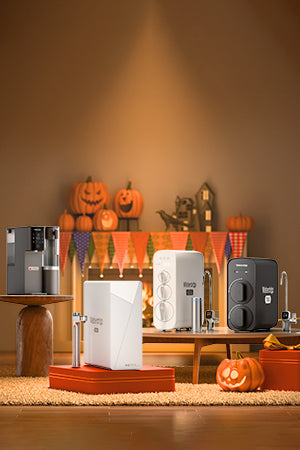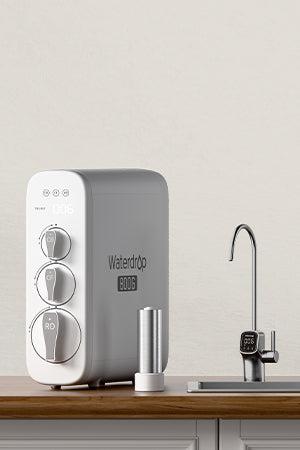Reverse osmosis (RO) is one of the most effective and widely used water purification methods globally. From
enhancing drinking water quality to supporting industrial processes, it can remove up to 99% of dissolved
contaminants from water.
But how exactly does this technology work? And why should European households consider it?
This guide explains the science behind reverse osmosis, its practical benefits, and how to choose the
right
RO system for your needs.
What Is Reverse
Osmosis?
Reverse osmosis is a water purification method that pushes water through a special membrane. This membrane has
tiny pores – just 0.0001 microns wide. Only water molecules can fit through these pores. Everything else gets
trapped and washed away.
Think of it like a super-fine strainer at the molecular level. Salt, minerals, bacteria, and chemicals are too
big to pass through. Only H₂O molecules make it to your glass.
The membrane has pores measuring just 0.0001 microns. To put this in perspective:
- Human hair: 50-70 microns wide
- Bacteria: 1-10 microns
- RO membrane pores: 0.0001 microns
- Water molecule: 0.0002 microns
Only water molecules are small enough to squeeze through these tiny pores.
How Does Reverse
Osmosis Work?
Osmosis is a natural process where water moves from a region of low solute concentration (e.g., fresh water) to
a region of high solute concentration (e.g., saltwater) through a semipermeable membrane.
Reverse osmosis is the reversal of the natural flow of osmosis. By applying external pressure, water is pushed
from a high solute concentration area through the semipermeable membrane to the low solute concentration side.
This process removes up to 99% of dissolved salts, heavy metals, and other contaminants.
The Multi-Stage
RO Journey: How Your Water Gets Purified
Let's follow a water droplet through an RO system:
Stage 1:
Pre-Filtration (The Bodyguards)
Sediment Filter - The Bouncer: Like a bouncer checking IDs at a club entrance, this filter stops the
obvious troublemakers:
- Sand and dirt (5-10 microns)
- Rust particles from old pipes
- Any visible particles
Stage 2: The RO
Membrane (The VIP Section)
This is where magic happens. The membrane is like an extremely exclusive VIP area where only water molecules
have passed.
-
Salt (sodium chloride): Too big, 95% blocked
-
Calcium and magnesium (hardness): Can't fit, 98% blocked
-
Lead: Way too large, 98% blocked
-
Bacteria: Giants compared to the pores, 99.9% blocked
-
Viruses: Still too big, 99% blocked
The Separation Process: As water is pushed through:
- Clean water passes through the membrane
- Contaminants concentrate on the dirty side
- This concentrated waste (called brine) is flushed away
- Pure water continues to the next stage
Stage 3:
Post-Filtration (The Finishing Touch)
Carbon Polish Filter: Like a final quality check, this removes any lingering tastes that might have
developed during storage.
Remineralization (Optional): Some systems add back beneficial minerals. Think of it as adding a pinch of
salt to improve the taste of your cooking – but with healthy minerals like calcium and magnesium.
Benefits of
Reverse Osmosis Water Filtration System
Reverse osmosis systems offer practical solutions to water quality challenges facing European households today.
Let's look at the
specific benefits.
Improved Drinking
Water Quality
Reverse osmosis significantly enhances drinking water quality by effectively removing harmful contaminants such
as lead, nitrates, and pesticides.
This purification process is particularly advantageous in areas where agricultural runoff or aging plumbing
systems compromise water safety. This matters particularly in Europe, where aging infrastructure poses ongoing
challenges.
Lead Removal
Lead contamination often arises from corroding old pipes and plumbing fixtures, posing serious health risks,
especially to children.
As
the European
Food Safety Authority notes that "school performance may be adversely affected by early
childhood exposure to lead". RO systems can reduce lead from drinking water, ensuring safer consumption.
Pesticide Reduction
The
European Environment Agency's 2024 water report highlights ongoing challenges
with pesticide contamination.
Pesticides used in agriculture can infiltrate water supplies through runoff, leading to potential long-term
health effects from chronic exposure. RO membranes are capable of rejecting a wide range of pesticides,
significantly reducing their presence in drinking water.
Reduction of Hard
Water Issues
Water hardness affects millions of European households. Cities like Würzburg, Germany and regions across France
and Spain face significant limescale challenges
Reverse osmosis systems effectively reduce water hardness by removing these minerals, thereby mitigating
limescale formation.
This process extends the longevity of appliances such as kettles and washing machines, ensuring they function
optimally over time.
Eco-Friendly
Alternative
By using reverse osmosis, you can reduce reliance on bottled water, which helps to reduce the consumption of
single-use plastic bottles.
This approach helps create a healthier environment. It reduces landfill waste and ocean pollution. You also live
more sustainably by cutting down on bottled water production and transportation. This means a smaller carbon
footprint for your household.
How to Choose a
Reverse Osmosis System
Selecting the right reverse osmosis system is crucial for ensuring access to clean, safe, and great-tasting
water. When selecting a reverse osmosis system, consider the following factors to match your specific needs.
1. Determine Your Water
Quality Needs
Start by testing your water. You can use a home water testing kit or have your water analyzed by a professional.
In Europe, water quality standards are generally high due to strict EU regulations, but regional variations
exist.
Contaminants present: Common impurities include chlorine, lead, nitrates, and fluoride. Agricultural
nitrates are common in the Netherlands, Denmark, and northern France.
Water hardness: High levels of calcium and magnesium can cause limescale. This is particularly
problematic in European countries like Germany, and northern Italy.
Taste and odor issues: Chlorine and sulfur are common culprits. European municipal water often has
chlorine taste, while areas near geothermal activity may experience sulfur odors.
2. Decide on the
Filtration Stages
RO systems vary in the number of filtration stages they offer. Each stage removes specific contaminants, so more
stages typically mean better filtration.
3-Stage Systems: Basic filtration for removing large particles, chlorine, and sediments.
5-Stage Systems: Common in homes; these remove smaller contaminants like heavy metals and provide
comprehensive filtration.
Advanced Systems: Some include UV light for sterilization or remineralization filters that add healthy
minerals back into the water.
Given Europe's generally good source of water quality, 3-stage systems often suffice for urban areas, while
5-stage systems are ideal for hard water regions.
3. Choose Between Tank
and Tankless Systems
Tank Systems: These systems store purified water in a tank, ensuring water availability even when demand is
high. They are ideal for larger households.
Tankless Systems: Compact and space-saving, these systems filter water on demand and reduce the risk of
bacterial growth. They are a great choice for modern kitchens with limited space.
Tankless systems are increasingly popular in Europe due to space constraints in urban apartments. They're
particularly suitable for the typical European family size of 2-4 people.
4. Check Water
Efficiency
Traditional RO systems waste more water than they purify, often with a 3:1 wastewater ratio. Modern systems have
improved this significantly.
Look for a system with a low wastewater ratio (e.g., 1:1 or better) to save water and reduce costs. Now more and
more brands have replaced "waste water ratio" with "Pure to drain water ratio"
Water efficiency is crucial for environmentally conscious European consumers. Aim for systems with 2:1 or 3:1
pure-to-drain water ratios maximum.
5. Consider Flow Rate
and Daily Output
Flow rate refers to how quickly water is filtered and delivered. This depends on your household's water
consumption.
Low-demand households: Systems producing 50–75 gallons per day (GPD) are sufficient.
High-demand households: Choose a system with a higher output (e.g., 200+ GPD).
6. Evaluate Maintenance
Requirements
Regular maintenance ensures the system continues to operate efficiently.
- Filter replacement. Most prefilters and postfilters need replacement every months. RO membranes last
years.
- Ease of maintenance. Look for systems with twistandlock filters or indicator lights for replacement
reminders.
7. Assess Installation
and Space Requirements
Under Sink RO Water Filter System
It offers higher water output, better filtration capacity, and a hidden design for a tidy kitchen. It is
well-suited for homeowners, larger households, and long-term use, providing a more durable and permanent
solution for high water demand.
The
Waterdrop
X12 tankless RO system delivers impressive 1200 GPD rapid flow, so your family never waits for
clean water. The smart digital faucet shows water quality in real-time. Perfect for those who cook frequently
and need reliable, high-quality water daily.
Countertop RO Water Filter System
It is compact, portable, and easy to install without plumbing modifications, making them ideal for renters,
small households, and temporary setups. It is budget-friendly, require minimal maintenance, and fit well in
spaces like apartments, offices, or dorms.
The
Waterdrop A2 RO water filter gives you instant hot and cold water. Great for
European renters who move
between apartments in cities like Berlin or Barcelona. No plumbing needed - just plug in and start using it. The
compact design fits perfectly
Conclusion
Reverse osmosis is a powerful and reliable solution for improving water quality. Whether you’re dealing with
hard water, pollutants, or simply want better-tasting drinking water, an RO system can provide significant
benefits.
By understanding how reverse osmosis works and its advantages, you can make an informed decision to enhance your
water supply.




























































